We decided to have just one more jungle adventure before leaving the Amazon. JH had his heart set on finding Sarayaku (Sarayacu), an indigenous community somewhere in the Amazon in Ecuador. We were inspired by this video we saw about the delegation from Sarayaku to the COP21 climate summit in Paris.
The problem is we had no idea where Sarayaku is or how to get there. Even though I really wanted to go too I was secretly a bit over the jungle for now – the heat, the insect bites, sleeping on the floor, lack of privacy, toilets and showers. My superficial self was looking forward to being clean and comfortable. Ah well, it could wait. If we could find it we’d go.
We were told we’d have to go south to Puyo, another jungle town, as the starting point. Puyo was much more pleasant than expected. It’s a bit cooler and it rains a lot. They have 320mm of rain per month here. Every month. There’s coffee and hot showers. Bliss. There are at least five distinct Amazon tribes in this region and so much wilderness. You could spend a lifetime exploring here. The statue in the town centre honours the rain and the meeting of cultures.

A one line entry in Lonely Planet said that a small company called ‘Papangu’ in Puyo goes to Sarayaku. We eventually found their office but it was closed. We sent them an email but no response. We door knocked everything that looked like a travel or tourist office and asked everyone we met about getting to Sarayaku but no luck. After a few days in Puyo we were ready to give up and head towards civilisation. Then, in the final hour, we got an email back from Papangu. We were a bit unclear exactly what it said when translated by Google from Spanish, so we headed down to the office again and at last it was open. We were met by Jose who is amazingly from Sarayaku. It turns out they are the only people who can organise access to Sarayaku. Lucky! We could leave the next morning with just a small bag. We had to leave our packs in Puyo. He said it would be an hour or two by 4xWD and then four hours by canoe. I was a bit apprehensive that I might have to paddle a canoe for four hours. I was relieved to see, when we got to the river, that the canoe (described as a ‘big boat’) had a motor. There were a lot of people that needed to fit into this ‘big boat’ though.
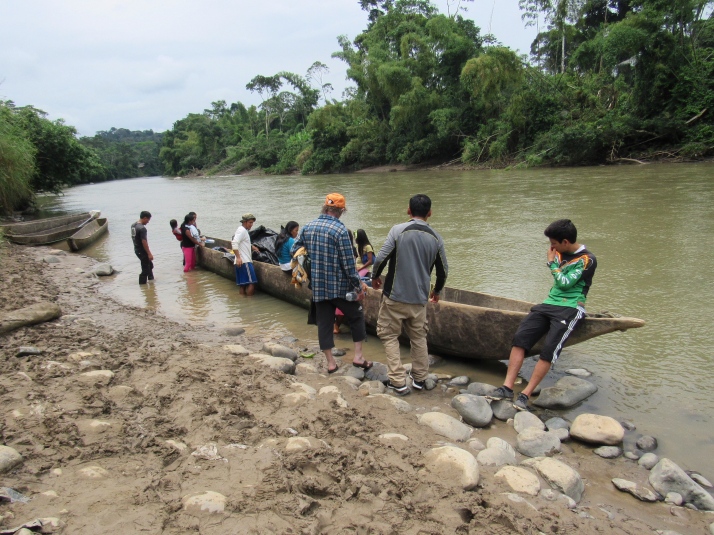
It was a magical trip down the Bobonanza river by canoe, albeit rather crowded and uncomfortable. The river is low at the moment so there were many patches of rocky shallow waters that had to be navigated by pole. There were also a few sections of rapids that, as JH said, was like white-water rafting in a 40 foot canoe. The river is clear and beautiful, with pristine jungle on both sides. Thankfully the canoe pulled up part-way through the trip for a picnic, so I was able to find a secluded spot for a toilet. Relief!

As we neared Sarayaku we started to see houses with thatched roofs (including many round ones), suspension foot bridges, canoes, children playing and people in the river. This is the Amazon as I imagined it. On arrival at our stop in Sarayaku we are met by Jose’s brother Gerardo. We would be staying with their family in the settlement of Kushilu Urku. Our sleeping quarters are upstairs in a big open sided hut with hammocks for relaxing and a mattress inside a tent for insect protection while sleeping.

Other family members have their own sleeping huts with a big communal hut and an adjacent kitchen hut, both with earth floors. Everything is spotlessly clean and so organised. There are drains and water channels throughout with planks across for bridges. No electricity. Bathing is in a stream with a separate stream for drinking.

There are many children, chickens and healthy happy dogs. The father is 93 years old and a very sprightly traditional medicine man and healer. He has a special carved chair he sits in in the communal hut.

Sarayaku is an amazing community for many reasons. The people are Kichwa (Quichua/Kichiwa), distinct from the Quechua in Peru. They’ve lived in these forests forever and every person knows every single plant and its uses, many medicinal. They’ve maintained their traditional knowledge and way of life, while taking only the small parts they want from the modern world. Everything in Sarayaku is decided as a community. 1200 people live here in the six settlements that make up the territory of Sarayaku, of which Kushilu Urku is one.

There is a ‘Centro’ administrative centre that serves all of Sarayaku. It has a satellite communications centre and a solar power system, similar to our own at home in Australia. Centro is up on a high hill and we were told that this is because, sometime in the past, the neighbouring indigenous Shuar people snuck in and kidnapped a woman from Sarayaku. This caused a big war, so now they can see people coming. Gerardo likened it to The Trojan wars, also fought over the kidnapped Helen. There is a small research library here and a hut with satellite internet. There’s also a hospital and a community bank but no shops. Any special purchases are brought by canoe or plane from Puyo. There isn’t much as they have almost everything they need from the forest. The community has a football (soccer) coach from Esmerelda, so football is becoming popular.
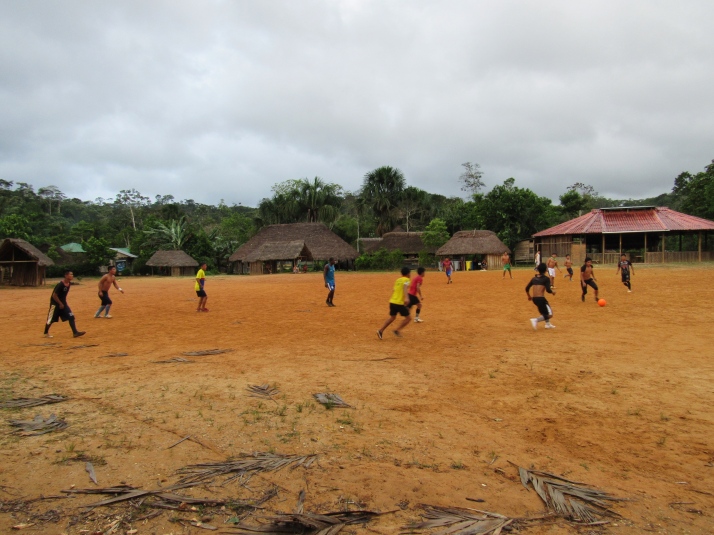
Surayaku is governed autonomously with their own council elected every three years. Anyone over the age of sixteen can stand for election and anyone can attend meetings and raise issues or contribute to discussions. It’s a true direct democracy. This is the council assembly hut in Centro with special chairs for the President and Vice President.


We met the current President who showed us his bucket of baby Caimans. He rescued them from the oil company upriver (where many areas of the Amazon have been contaminated and destroyed) and will return them to a safe river in Sarayaku.

Education and knowledge is highly valued in Sarayaku and each settlement has a bilingual school (Kichwa and Spanish) and a college where students learn practical skills such as agriculture.

The Kichwa people have always practiced some agriculture and are very industrious, constantly building, making, growing. They cultivate bananas, corn and yucca (their staple diet) supplemented by food from the forest. They cooked us amazing vegetarian food made from totally unfamiliar things. Their main drink is Chicha from the yucca plant. They drink the unfermented variety every day and ferment some as an alcoholic drink for special occasions. It’s fermented by the women chewing the yucca and spitting it into these groovy pots to sit.
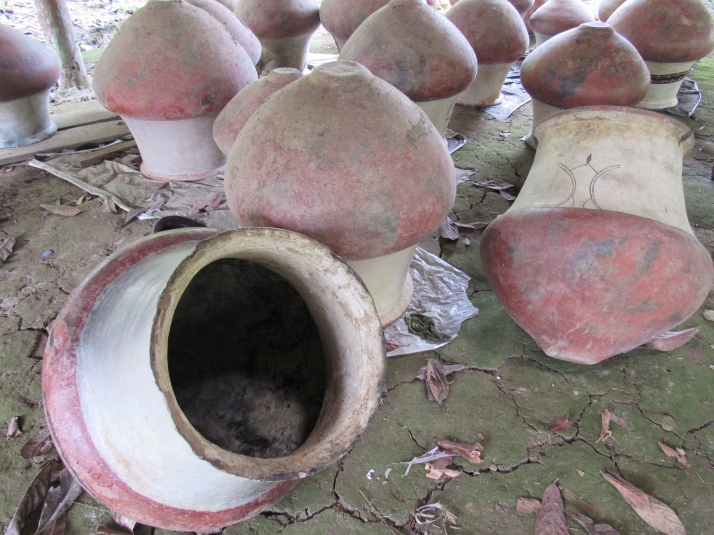
Gerardo took us for a ‘nature walk’ that turned out to be hours of climbing a steep, muddy and very slippery mountain. I fell over once on the way back down (even harder than going up) and almost took JH and Gerardo over the edge with me. I got my one pair of trousers caked in mud and had to wear an impractical long dress for the rest of my stay. Apart from the mud and the climbing it was a beautiful walk in the forest and we learnt so much about the plants.

The most useful plant to me was the ‘toilet paper tree’. I’d been wondering for ages how everyone managed to go to the toilet in the jungle without toilet paper. Now I know. This is it.
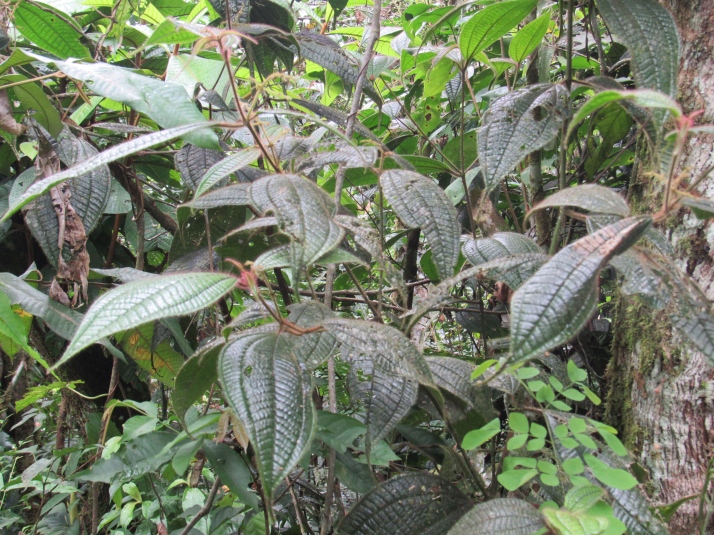
The other amazing thing about Sarayaku is that they fought an American oil company and won. In 2002 the Ecuador government gave Texaco rights to drill for oil on Sarayaku land. The people weren’t consulted or informed. They were obviously horrified at the invasion and fought back by carrying out constant peaceful direct action. I asked Gerardo how they did it and he said the women and children continually blocked the planes and workers and they filmed everything and sent it around the world. They also hired lawyers and mounted legal and human rights challenges. It took many years and at one stage the Ecuador government even sent in the army. This video tells the story perfectly.
The Sarayaku are cohesive, organised and committed. They now have their own army – an army of peace not war. They patrol the borders and watch for invaders. They’ve planted tall trees with distinctive flowers along every border, so in fourteen years the area of their territory will be clearly visible from the air. The people of Sarayaku are an inspiration. Unfortunately, although they won the battle the war is ongoing. Now a Chinese oil company has their sights set on Sarayaku and the Ecuador government seem prepared to sell out the Sarayaku to pay their debts to China. As with everywhere in the world it’s a never ending story.
Apparently we are the first people from Australia to ever visit Sarayaku. JH gave Gerardo our little solar phone charger and a pair of binoculars when we left. He was so happy! We learnt so much and now feel strongly connected. I almost had a tear when getting on the tiny plane to fly back to Puyo. This is somewhere I hope I will return to someday.

To support the Sarayaku community in their fight against the oil companies the best thing you can do is visit them, share their story and/or sign petitions here and here.
More photos from Ecuador here.
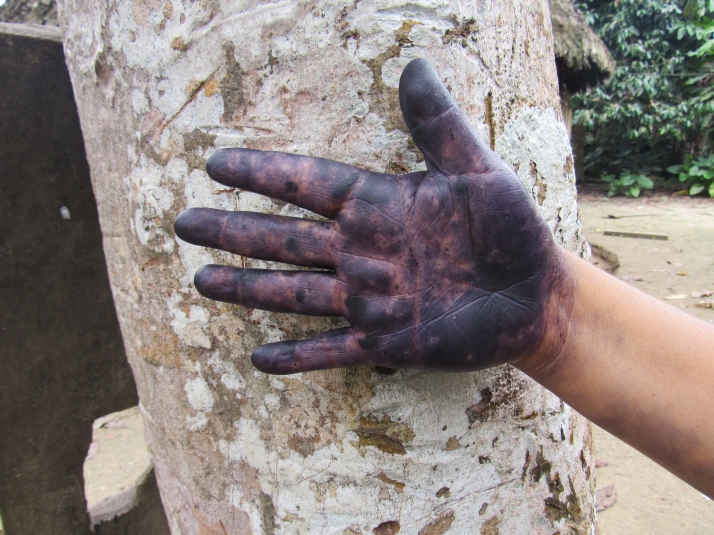

Another inspirational blog, what an adventure will check out the people video we can learn so much from them x
LikeLike
Yes Lisa check out the videos. They really give a feel for the place.
LikeLike
Fantastic story once again Jeanne. Thank you for sharing these amazing adventures. Sounds like an amzing time
LikeLike
Cheers Greg 🙂 having an awesome time!
LikeLike
Amazing people – thanks for sharing Jeanne
LikeLiked by 1 person
Reblogged this on Sirens of Silence and commented:
A traveler’s experience with the Sarayaku village. Great insight to the community and beautiful images.
LikeLike
Thanks for enjoying and sharing 🙂
LikeLike
Hi, I am thinking of visiting this place too. I can speak a little Spanish but I am not fluent. Will that make it difficult?
Also, could you tell me how much it cost?
LikeLike
Hi Tej. I highly recommend it! Such a wonderful experience. We had VERY basic Spanish only and had no problem communicating. Gerardo will probably be your guide and he speaks a bit of English. The main language difficulty was when trying to book in Puyo. Once you’ve organised that, the rest is easy. I can’t remember how much it cost but I think it was around US$100 per person per day (inclusive) from Puyo. If you want to return by small plane to Puyo it may be extra.
LikeLike
Thanks to Jack for giving me the link. The photos are stupendous and I look forward to reading this and following the links.
LikeLike
Thanks Johnny! I hope you enjoy it 🙂
LikeLike